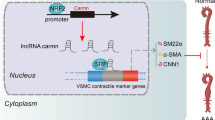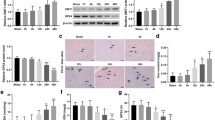Abstract
Nuclear-enriched abundant transcript 1 (NEAT1), a vital long noncoding RNA (lncRNA), exhibits the functions in disparate cancers. Nevertheless, the influences of NEAT1 in congenital heart disease (CHD) remain unreported. The research delves into whether NEAT1 affects H9c2 cells apoptosis and autophagy under the hypoxia condition. Overexpressed NEAT1 vector was transfected into H9c2 cells; then, functions of NEAT1 in cell viability, apoptosis, autophagy, PI3K/AKT/mTOR and JAK1/STAT3 pathways were detected in H9c2 cells under hypoxia condition. Expression of NEAT1 and miR-181b in hypoxia and blood samples from CHD was evaluated. After miR-181b inhibitor transfection, functions of miR-181b repression in the above-mentioned cell behavior and PI3K/AKT/mTOR and JAK1/STAT3 pathways were reassessed. Overexpressed NEAT1 clearly allayed hypoxia-triggered H9c2 cells apoptosis and autophagy. The decreased NEAT1 and miR-181b were showcased in hypoxia and blood samples from CHD; meanwhile, elevated miR-181b evoked by overexpressed NEAT1 was observed in hypoxia-managed H9c2 cells. More importantly, miR-181b inhibition obviously overturned the influences of NEAT1 in hypoxia-affected H9c2 cells apoptosis and autophagy. Besides, overexpressed NEAT1 facilitated PI3K/AKT/mTOR and JAK1/STAT3 activations via enhancing miR-181b. The research exposed that NEAT1 eased hypoxia-triggered H9c2 cells apoptosis and autophagy by expediting PI3K/AKT/mTOR and JAK1/STAT3 pathways via elevating miR-181b.






Similar content being viewed by others
Availability of data and materials
The datasets used and/or analyzed during the current study are available from the corresponding author on a reasonable request.
References
Meier LM, Meineri M, Qua Hiansen J, Horlick EM (2017) Structural and congenital heart disease interventions: the role of three-dimensional printing. Neth Heart J 25:65–75. https://doi.org/10.1007/s12471-016-0942-3
Simpson J, Lopez L, Acar P, Friedberg M, Khoo N, Ko H, Marek J, Marx G, McGhie J, Meijboom F, Roberson D, Van den Bosch A, Miller O, Shirali G (2016) Three-dimensional echocardiography in congenital heart disease: an expert consensus document from the European Association of Cardiovascular Imaging and the American Society of Echocardiography. Eur Heart J Cardiovasc Imaging 17:1071–1097. https://doi.org/10.1093/ehjci/jew172
Egbe A, Uppu S, Lee S, Ho D, Srivastava S (2014) Prevalence of associated extracardiac malformations in the congenital heart disease population. Pediatr Cardiol 35:1239–1245. https://doi.org/10.1007/s00246-014-0922-6
Holst KA, Dearani JA, Burkhart HM, Connolly HM, Warnes CA, Li Z, Schaff HV (2011) Risk factors and early outcomes of multiple reoperations in adults with congenital heart disease. Ann Thorac Surg 92:122–128. https://doi.org/10.1016/j.athoracsur.2011.03.102(discussion 129-30)
Li H, Luo M, Zheng J, Luo J, Zeng R, Feng N, Du Q, Fang J (2017) An artificial neural network prediction model of congenital heart disease based on risk factors: a hospital-based case-control study. Medicine (Baltimore) 96:e6090. https://doi.org/10.1097/md.0000000000006090
Nattel SN, Adrianzen L, Kessler EC, Andelfinger G, Dehaes M, Cote-Corriveau G, Trelles MP (2017) Congenital heart disease and neurodevelopment: clinical manifestations, genetics, mechanisms, and implications. Can J Cardiol 33:1543–1555. https://doi.org/10.1016/j.cjca.2017.09.020
Zorzanelli L, Maeda N, Clave M, Thomaz A, Galas F, Rabinovitch M, Lopes A (2017) Relation of cytokine profile to clinical and hemodynamic features in young patients with congenital heart disease and pulmonary hypertension. Am J Cardiol 119:119–125. https://doi.org/10.1016/j.amjcard.2016.09.020
Schranz D, Michel-Behnke I (2013) Advances in interventional and hybrid therapy in neonatal congenital heart disease. Semin Fetal Neonatal Med 18:311–321. https://doi.org/10.1016/j.siny.2013.05.005
Bhan A, Soleimani M, Mandal SS (2017) Long noncoding rna and cancer: a new paradigm. Cancer Res 77:3965–3981. https://doi.org/10.1158/0008-5472.can-16-2634
Scheuermann JC, Boyer LA (2013) Getting to the heart of the matter: long non-coding RNAs in cardiac development and disease. EMBO J 32:1805–1816. https://doi.org/10.1038/emboj.2013.134
Devaux Y, Zangrando J, Schroen B, Creemers EE, Pedrazzini T, Chang CP, Dorn GW 2nd, Thum T, Heymans S (2015) Long noncoding RNAs in cardiac development and ageing. Nat Rev Cardiol 12:415–425. https://doi.org/10.1038/nrcardio.2015.55
Song G, Shen Y, Zhu J, Liu H, Liu M, Shen YQ, Zhu S, Kong X, Yu Z, Qian L (2013) Integrated analysis of dysregulated lncRNA expression in fetal cardiac tissues with ventricular septal defect. PLoS ONE 8:e77492. https://doi.org/10.1371/journal.pone.0077492
Jiang Y, Mo H, Luo J, Zhao S, Liang S, Zhang M, Yuan J (2018) HOTAIR is a potential novel biomarker in patients with congenital heart diseases. BioMed Res Int 2018:2850657. https://doi.org/10.1155/2018/2850657
Pan LJ, Zhong TF, Tang RX, Li P, Dang YW, Huang SN, Chen G (2015) Upregulation and clinicopathological significance of long non-coding NEAT1 RNA in NSCLC tissues. Asian Pac J Cancer Prev 16:2851–2855. https://doi.org/10.7314/apjcp.2015.16.7.2851
Chakravarty D, Sboner A, Nair SS, Giannopoulou E, Li R, Hennig S, Mosquera JM, Pauwels J, Park K, Kossai M, MacDonald TY, Fontugne J, Erho N, Vergara IA, Ghadessi M, Davicioni E, Jenkins RB, Palanisamy N, Chen Z, Nakagawa S, Hirose T, Bander NH, Beltran H, Fox AH, Elemento O, Rubin MA (2014) The oestrogen receptor alpha-regulated lncRNA NEAT1 is a critical modulator of prostate cancer. Nat Commun 5:5383. https://doi.org/10.1038/ncomms6383
Wu Y, Yang L, Zhao J, Li C, Nie J, Liu F, Zhuo C, Zheng Y, Li B, Wang Z, Xu Y (2015) Nuclear-enriched abundant transcript 1 as a diagnostic and prognostic biomarker in colorectal cancer. Mol Cancer 14:191. https://doi.org/10.1186/s12943-015-0455-5
Tian J, An X, Niu L (2017) Role of microRNAs in cardiac development and disease. Exp Ther Med 13:3–8. https://doi.org/10.3892/etm.2016.3932
Smith T, Rajakaruna C, Caputo M, Emanueli C (2015) MicroRNAs in congenital heart disease. Ann Transl Med 3:333. https://doi.org/10.3978/j.issn.2305-5839.2015.12.25
Pang XF, Lin X, Du JJ, Zeng DY (2019) Downregulation of microRNA-592 protects mice from hypoplastic heart and congenital heart disease by inhibition of the Notch signaling pathway through upregulating KCTD10. J Cell Physiol 234:6033–6041
Wang L, Tian D, Hu J, Xing H, Sun M, Wang J, Jian Q, Yang H (2016) MiRNA-145 regulates the development of congenital heart disease through targeting FXN. Pediatr Cardiol 37:629–636. https://doi.org/10.1007/s00246-015-1325-z
Livak KJ, Schmittgen TD (2001) Analysis of relative gene expression data using real-time quantitative PCR and the 2− ΔΔCT method. Methods 25:402–408
Rotini A, Martinez-Sarra E, Pozzo E, Sampaolesi M (2018) Interactions between microRNAs and long non-coding RNAs in cardiac development and repair. Pharmacol Res 127:58–66. https://doi.org/10.1016/j.phrs.2017.05.029
Gong L, Xu H, Chang H, Tong Y, Zhang T, Guo G (2018) Knockdown of long non-coding RNA MEG3 protects H9c2 cells from hypoxia-induced injury by targeting microRNA-183. J Cell Biochem 119:1429–1440. https://doi.org/10.1002/jcb.26304
Gong LC, Xu HM, Guo GL, Zhang T, Shi JW, Chang C (2017) Long non-coding RNA H19 protects H9c2 cells against hypoxia-induced injury by targeting MicroRNA-139. Cell Physiol Biochem 44:857–869. https://doi.org/10.1159/000485354
Yan W, Chen ZY, Chen JQ, Chen HM (2018) LncRNA NEAT1 promotes autophagy in MPTP-induced Parkinson’s disease through stabilizing PINK1 protein. Biochem Biophys Res Commun 496:1019–1024. https://doi.org/10.1016/j.bbrc.2017.12.149
Wang X (2018) Down-regulation of lncRNA-NEAT1 alleviated the non-alcoholic fatty liver disease via mTOR/S6K1 signaling pathway. J Cell Biochem 119:1567–1574. https://doi.org/10.1002/jcb.26317
Huang S, Qian K, Zhu Y, Huang Z, Luo Q, Qing C (2017) Diagnostic value of the lncRNA NEAT1 in peripheral blood mononuclear cells of patients with sepsis. Dis Markers 2017:7962836. https://doi.org/10.1155/2017/7962836
Qi L, Liu F, Zhang F, Zhang S, Lv L, Bi Y, Yu Y (2018) lncRNA NEAT1 competes against let-7a to contribute to non-small cell lung cancer proliferation and metastasis. Biomed Pharmacother 103:1507–1515. https://doi.org/10.1016/j.biopha.2018.04.053
Zhang L, He X, Li F, Pan H, Huang X, Wen X, Zhang H, Li B, Ge S, Xu X, Jia R, Fan X (2018) The miR-181 family promotes cell cycle by targeting CTDSPL, a phosphatase-like tumor suppressor in uveal melanoma. J Exp Clin Cancer Res 37:15. https://doi.org/10.1186/s13046-018-0679-5
Chen H, Chen Q, Fang M, Mi Y (2010) microRNA-181b targets MLK2 in HL-60 cells. Sci China Life Sci 53:101–106. https://doi.org/10.1007/s11427-010-0002-y
Cui B, Li B, Liu Q, Cui Y (2017) lncRNA CCAT1 promotes glioma tumorigenesis by sponging miR-181b. J Cell Biochem 118:4548–4557. https://doi.org/10.1002/jcb.26116
Liu X, Hou L, Huang W, Gao Y, Lv X, Tang J (2016) The mechanism of long non-coding RNA MEG3 for neurons apoptosis caused by hypoxia: mediated by miR-181b-12/15-LOX signaling pathway. Front Cell Neurosci 10:201. https://doi.org/10.3389/fncel.2016.00201
Li S, Yang J, Xia Y, Fan Q, Yang KP (2018) Long noncoding RNA NEAT1 promotes proliferation and invasion via targeting miR-181a-5p in non-small cell lung cancer. Oncol Res 26:289–296. https://doi.org/10.3727/096504017x15009404458675
Vo BT, Morton D Jr, Komaragiri S, Millena AC, Leath C, Khan SA (2013) TGF-beta effects on prostate cancer cell migration and invasion are mediated by PGE2 through activation of PI3K/AKT/mTOR pathway. Endocrinology 154:1768–1779. https://doi.org/10.1210/en.2012-2074
Qin L, Fan S, Jia R, Liu Y (2018) Ginsenoside Rg1 protects cardiomyocytes from hypoxia-induced injury through the PI3K/AKT/mTOR pathway. Pharmazie 73:349–355. https://doi.org/10.1691/ph.2018.8329
Li XD, Li XM, Gu JW, Sun XC (2017) MiR-155 regulates lymphoma cell proliferation and apoptosis through targeting SOCS3/JAK-STAT3 signaling pathway. Eur Rev Med Pharmacol Sci 21:5153–5159. https://doi.org/10.26355/eurrev_201711_13832
Lu Y, Gu Y, Ding X, Wang J, Chen J, Miao C (2017) Intracellular Ca2+ homeostasis and JAK1/STAT3 pathway are involved in the protective effect of propofol on BV2 microglia against hypoxia-induced inflammation and apoptosis. PLoS ONE 12:e0178098
Li B, Gu W, Zhu X (2019) NEAT1 mediates paclitaxel-resistance of non-small cell of lung cancer through activation of Akt/mTOR signalling pathway. J Drug Target 27:1–7
Xu H, Li J, Zhou Z (2018) NEAT1 promotes cell proliferation in multiple myeloma by activating PI3K/AKT pathway. Eur Rev Med Pharmacol Sci 22:6403–6411
Guo HM, Yang SH, Zhao SZ, Li L, Yan MT, Fan MC (2018) LncRNA NEAT1 regulates cervical carcinoma proliferation and invasion by targeting AKT/PI3K. Eur Rev Med Pharmacol Sci 22:4090–4097. https://doi.org/10.26355/eurrev_201807_15400
Zhang XN, Zhou J, Lu XJ (2018) The long noncoding RNA NEAT1 contributes to hepatocellular carcinoma development by sponging miR-485 and enhancing the expression of the STAT3. J Cell Physiol 233:6733–6741. https://doi.org/10.1002/jcp.26371
Chang L, Chai X, Chen P, Cao J, Xie H, Zhu J (2019) miR-181b-5p suppresses starvation-induced cardiomyocyte autophagy by targeting Hspa5. Int J Mol Med 43:143–154
Iliopoulos D, Jaeger SA, Hirsch HA, Bulyk ML, Struhl K (2010) STAT3 activation of miR-21 and miR-181b-1 via PTEN and CYLD are part of the epigenetic switch linking inflammation to cancer. Mol Cell 39:493–506. https://doi.org/10.1016/j.molcel.2010.07.023
Acknowledgments
No.
Funding
This research did not receive any specific grant from funding agencies in the public, commercial, or not-for-profit sectors.
Author information
Authors and Affiliations
Contributions
JW conceived and designed the experiments; YL, ZL, JH, JY and YD performed the experiments and analyzed the data; and YL and JW wrote the manuscript.
Corresponding author
Ethics declarations
Conflict of interest
The authors declare that they have no conflict of interest.
Consent for publication
All authors are informed and agree to publish.
Additional information
Publisher's Note
Springer Nature remains neutral with regard to jurisdictional claims in published maps and institutional affiliations.
Rights and permissions
About this article
Cite this article
Lv, Y., Liu, Z., Huang, J. et al. LncRNA nuclear-enriched abundant transcript 1 regulates hypoxia-evoked apoptosis and autophagy via mediation of microRNA-181b. Mol Cell Biochem 464, 193–203 (2020). https://doi.org/10.1007/s11010-019-03660-2
Received:
Accepted:
Published:
Issue Date:
DOI: https://doi.org/10.1007/s11010-019-03660-2




